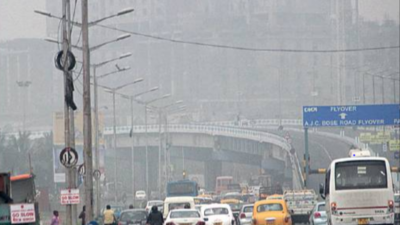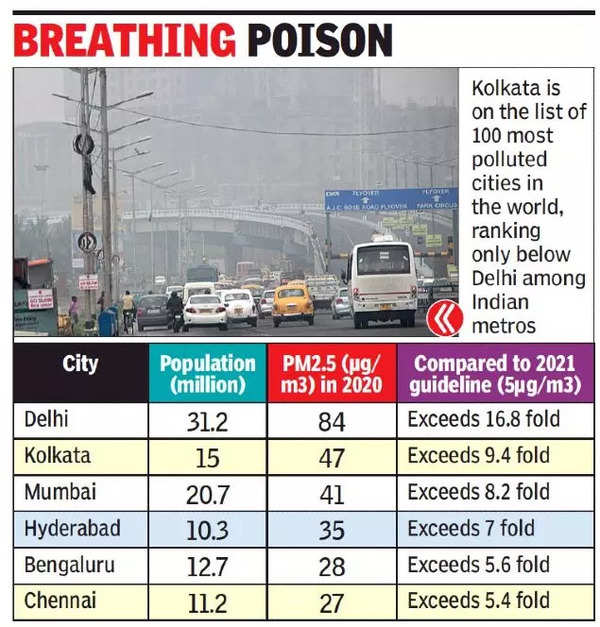- News
- City News
- kolkata News
- PM2.5 in Kolkata air 9.4 times new WHO limit
Trending
This story is from September 23, 2021
PM2.5 in Kolkata air 9.4 times new WHO limit
The challenge to meet permissible air quality standards in Kolkata got tougher on Wednesday with World Health Organisation (WHO) making the guidelines more stringent, claiming it had evidence that air pollution damaged human health at lower concentrations than previously understood. The last guideline was set in 2005.

Kolkata is on the list of 100 most polluted cities in the world, ranking only below Delhi among Indian metros
KOLKATA: The challenge to meet permissible air quality standards in Kolkata got tougher on Wednesday with World Health Organisation (WHO) making the guidelines more stringent, claiming it had evidence that air pollution damaged human health at lower concentrations than previously understood. The last guideline was set in 2005.
On Wednesday, WHO lowered all permissible standards, including annual mean of PM2.5 from 10µg/m3 to 5µg/m3, 24-hour average from 25µg/m3 to 15µg/m3, annual PM10 from 20µg/m3 to 15µg/m3 and 24-hour average from 50µg/m3 to 45µg/m3.Annual mean of NO2 was lowered from 40µg/m3 to 10µg/m3. The only exception was SO2 — its 24-hour average was increased from 20µg/m3 to 40µg/m3.

Kolkata’s annual mean PM2.5 level in 2020 at 47µg/m3 was 9.4 times the new permissible limit. Kolkata, which features among 100 most polluted cities in the world, ranks only below Delhi among Indian metros.
Global environment action group Greenpeace observed that the Indian national standard remains far more relaxed, allowing release of higher pollutants. Annual average of PM2.5 at 40µg/m3 is eight times less stringent than WHO’s and the 24-hour average standard is four times less stringent.
“Human health is not determined by the variation in permissible standards between WHO and India. As a medical practitioner, I should go by the WHO standard, which is scientifically calibrated and evidence-based,” said pulmonologist
In South Asia, where air pollution levels are consistently high, these new guidelines will bring renewed interest in the topic and create an opportunity to push for stronger action. Over 90% of the world’s population lives in areas that exceed the limits for key air pollutants set by WHO. Unfortunately for South Asia, this is approximately 100%.
“There are no two ways about the need to revise India’s air quality standards to make them more stringent. Even at the current relaxed standard of 40µg/m3 for annual PM2.5 average in India vs WHO’s 2005 annual limit of 10µg/m3, most Indian cities failed to meet the requirement. We also have to strengthen health data and revise the National Clean Air Programme. Raw health data is required to conduct a large range of health studies vis-a-vis air pollution impacts for India’s varied demography, exposure and differing PM2.5 composition. A single exposure prevention response will not suit the Indian population.” said S N Tripathi, professor, IIT-Kanpur and Steering Committee Member, National Clean Air Programme, India.
“Fossil fuels are the root cause of both air pollution and the climate crisis. Governments across South Asian countries need to urgently align their national air quality standards with the latest WHO guidelines and take a regional approach, keeping health at the heart of actions to tackle the crisis. The time to act was yesterday, but we missed it. For the sake of future generations, we need to commit to do everything it takes to solve this as early as possible,” said Arvind Kumar, founder, Lung Care Foundation & Chairman, Institute of Chest Surgery, Chest Onco Surgery and Lung Transplantation.
On Wednesday, WHO lowered all permissible standards, including annual mean of PM2.5 from 10µg/m3 to 5µg/m3, 24-hour average from 25µg/m3 to 15µg/m3, annual PM10 from 20µg/m3 to 15µg/m3 and 24-hour average from 50µg/m3 to 45µg/m3.Annual mean of NO2 was lowered from 40µg/m3 to 10µg/m3. The only exception was SO2 — its 24-hour average was increased from 20µg/m3 to 40µg/m3.

Kolkata’s annual mean PM2.5 level in 2020 at 47µg/m3 was 9.4 times the new permissible limit. Kolkata, which features among 100 most polluted cities in the world, ranks only below Delhi among Indian metros.
Track the pollution level in your city
Global environment action group Greenpeace observed that the Indian national standard remains far more relaxed, allowing release of higher pollutants. Annual average of PM2.5 at 40µg/m3 is eight times less stringent than WHO’s and the 24-hour average standard is four times less stringent.
“Human health is not determined by the variation in permissible standards between WHO and India. As a medical practitioner, I should go by the WHO standard, which is scientifically calibrated and evidence-based,” said pulmonologist
Arup Haldar. According to the ‘December 2020 Lancet Planetary Health Report’, pollution claimed 1.2 lakh lives in 2019 and caused an economic loss of around Rs 15,516 crore.
In South Asia, where air pollution levels are consistently high, these new guidelines will bring renewed interest in the topic and create an opportunity to push for stronger action. Over 90% of the world’s population lives in areas that exceed the limits for key air pollutants set by WHO. Unfortunately for South Asia, this is approximately 100%.
“There are no two ways about the need to revise India’s air quality standards to make them more stringent. Even at the current relaxed standard of 40µg/m3 for annual PM2.5 average in India vs WHO’s 2005 annual limit of 10µg/m3, most Indian cities failed to meet the requirement. We also have to strengthen health data and revise the National Clean Air Programme. Raw health data is required to conduct a large range of health studies vis-a-vis air pollution impacts for India’s varied demography, exposure and differing PM2.5 composition. A single exposure prevention response will not suit the Indian population.” said S N Tripathi, professor, IIT-Kanpur and Steering Committee Member, National Clean Air Programme, India.
“Fossil fuels are the root cause of both air pollution and the climate crisis. Governments across South Asian countries need to urgently align their national air quality standards with the latest WHO guidelines and take a regional approach, keeping health at the heart of actions to tackle the crisis. The time to act was yesterday, but we missed it. For the sake of future generations, we need to commit to do everything it takes to solve this as early as possible,” said Arvind Kumar, founder, Lung Care Foundation & Chairman, Institute of Chest Surgery, Chest Onco Surgery and Lung Transplantation.
End of Article
FOLLOW US ON SOCIAL MEDIA










